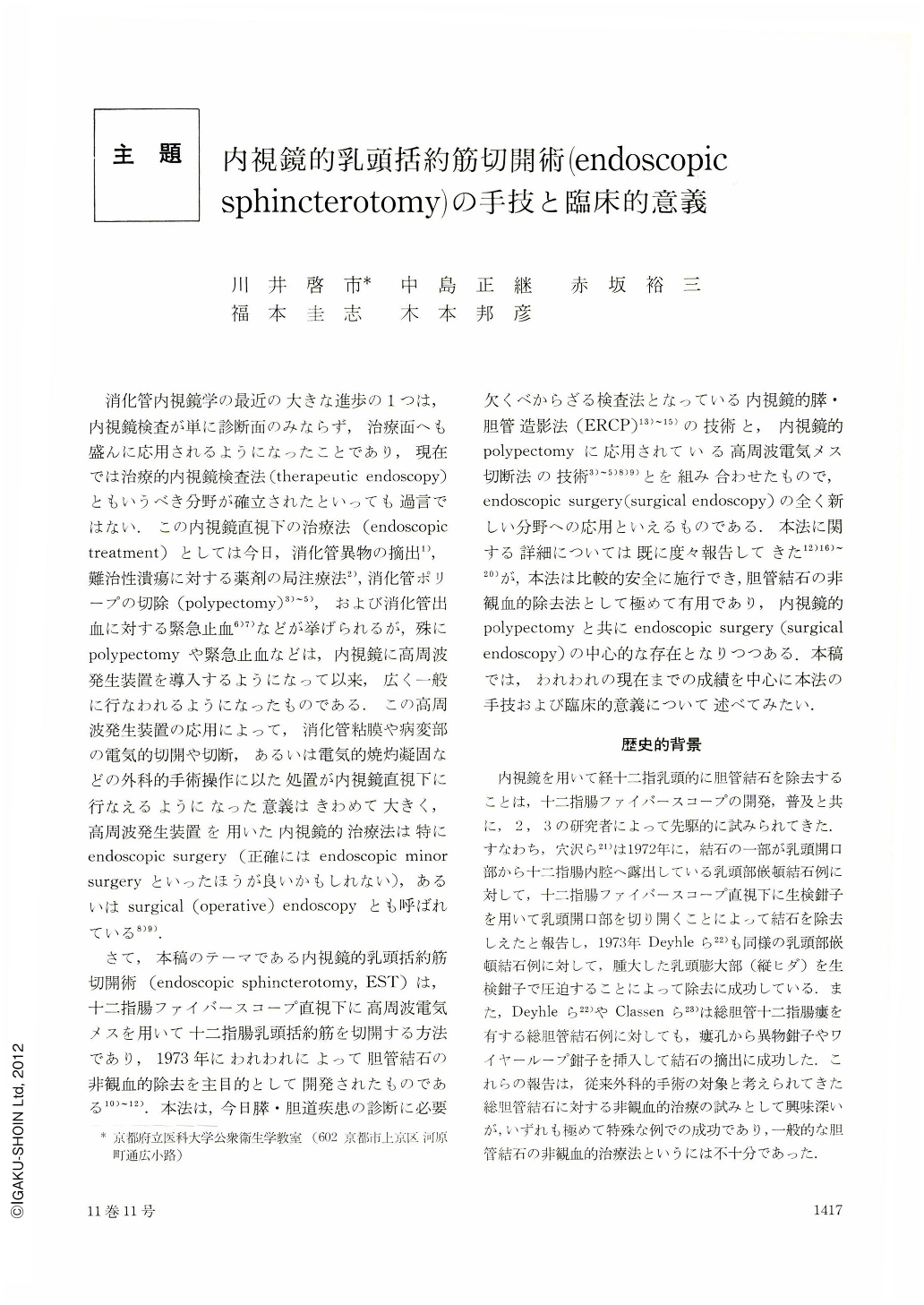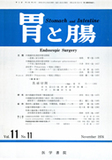Japanese
English
- 有料閲覧
- Abstract 文献概要
- 1ページ目 Look Inside
消化管内視鏡学の最近の大きな進歩の1つは,内視鏡検査が単に診断面のみならず,治療面へも盛んに応用されるようになったことであり,現在では治療的内視鏡検査法(therapeutic endoscopy)ともいうべき分野が確立されたといっても過言ではない.この内視鏡直視下の治療法(endoscopic treatment)としては今日,消化管異物の摘出1),難治性潰瘍に対する薬剤の局注療法2),消化管ポリープの切除(polypectomy)3)~5),および消化管出血に対する緊急止血6)7)などが挙げられるが,殊にpolypectomyや緊急止血などは,内視鏡に高周波発生装置を導入するようになって以来,広く一般に行なわれるようになったものである.この高周波発生装置の応用によって,消化管粘膜や病変部の電気的切開や切断,あるいは電気的焼灼凝固などの外科的手術操作に以た処置が内視鏡直視下に行なえるようになった意義はきわめて大きく,高周波発生装置を用いた内視鏡的治療法は特にendoscopic surgery(正確にはendoscopic minor surgeryといったほうが良いかもしれない),あるいはsurgical(operative)endoscopyとも呼ばれている8)9).
さて,本稿のテーマである内視鏡的乳頭括約筋切開術(endoscopic sphincterotomy,EST)は,十二指腸ファイバースコープ直視下に高周波電気メスを用いて十二指腸乳頭括約筋を切開する方法であり,1973年にわれわれによって胆管結石の非観血的除去を主目的として開発されたものである10)~12).本法は,今日膵・胆道疾患の診断に必要欠くべからざる検査法となっている内視鏡的膵・胆管造影法(ERCP)13)~15)の技術と,内視鏡的polypectomyに応用されている高周波電気メス切断法の技術3)~5)8)9)とを組み合わせたもので,endoscopic surgery(surgical endoscopy)の全く新しい分野への応用といえるものである.本法に関する詳細については既に度々報告してきた12)16)~20)が,本法は比較的安全に施行でき,胆管結石の非観血的除去法として極めて有用であり,内視鏡的polypectomyと共にendoscopic surgery(surgical endoscopy)の中心的な存在となりつつある.本稿では,われわれの現在までの成績を中心に本法の手技および臨床的意義について述べてみたい.
During the last three years from August of 1983 to July of 1876, endoscopic electrosurgical sphincterotomy was successfully accomplished on 35 of 40 patients; 32 of 36 for removal of biliary tract calculi and three of four for treatment of benign stenosis of the sphincter of Oddi. In the unsuccessful five, the electrode could not be correctly introduced into the distal end of the common duct because of technical or anatomical difficulties. Of these 32 cases with sphincterotomy for removal of calculi, calculi were completely removed in 26 cases (81.1%), that is, in 15 by spontaneous passage, in six by basket retrieval and in five by the combined use of both processes. The number of calculi removed in 26 cases was 47, 31 with spontaneous passage and 16 with basket retrieval, and they ranged from 5×5 mm to 30×25 mm in size. In the remaining six cases with sphincterotomy, removal of calculi was unsuccessful because of their multiplicity and size. In the three patients who had a benign stenosis of the sphincter with a relatively short narrow distal segment, endoscopic sphincterotomy was also effective for obviating the patients' symptoms and biliary stases. The aberrations of liver and pancreatic function tests noted before sphincterotomy returned to normal within three or four weeks after the procedure.
In our series, the complications were encountered in two of 35 cases during or following endoscopic sphincterotomy (5.7%); the one with a transient hyperamylasenemia and the other with an ampullary hemorrhage which were not severe and well managed by a conservative therapy. With follow-up observations of two to 36 months up to this time, neither stenosis nor obstruction of the sphincter has been noted. Only minimal to moderate insufficiency of the ampulla has been found, however, secondary cholangitis or pancreatitis possibly caused by the manipulation has not been encountered thus far.
Endoscopic electrosurgical sphincterotomy, a new-concept in therapeutic endoscopy, is now shown to be a practical and relatively safe procedure with a low complication rate if compared with surgical sphincterotomy. Not only can it be applied in patients unfit for operation, but will lessen the patients' physical discomfort and considerable economic loss with the removal of calculi by established surgical means. In recent reports and our summary regarding this technique, however, there were recognized some severe complications with mortality. In our opinion, therefore, this surgical endoscopy must be performed on carefully and strictly selected indications in experienced hands with good techniques of endoscopic retrograde cannulation and diathermic electrosurgery.

Copyright © 1976, Igaku-Shoin Ltd. All rights reserved.


